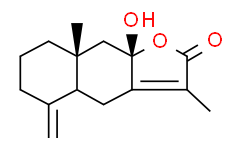| Cas No.: | 73030-71-4 |
| Chemical Name: | Atractylenolide III |
| Synonyms: | Atractylenolide III;8-HYDROXYASTEROLIDE;ATRACTYLENOLIDE;(4aS,8aR,9aS)-9a-Hydroxy-3,8a-dimethyl-5-methylidene-4,4a,6,7,8,9-hexahydrobenzo[f][1]benzoxol-2-one;(4aS)-4a,5,6,7,8,8a,9,9a-Octahydro-9aβ-hydroxy-3,8aβ-dimethyl-5-methylenenaphtho[2,3-b]furan-2(4H)-one;Atractylenolide Ⅲ;ATRACTYLENOLIDE III(AS);8β-Hydroxyasterolide;Atractylenolide-III;codonolactone;ICodonolactone;8beta-Hydroxyasterolide;Atractylodes japonica;8;A-Hydroxyasterolide;BCP18761;(4aS,8aR,9aS)-9a-hydroxy-3,8a-dimethyl-5-methylidene-4,4a,6,7,8,9-hexahydrobenzo[f][1]benzofuran-2-one;BDBM50241945;API0006576;Atractylenolide III, >=98% (HPLC);NCGC0038530 |
| SMILES: | O1C(C(C([H])([H])[H])=C2C([H])([H])[C@@]3([H])C(=C([H])[H])C([H])([H])C([H])([H])C([H])([H])[C@]3(C([H])([H])[H])C([H])([H])[C@]12O[H])=O |
| Formula: | C15H20O3 |
| M.Wt: | 248.3175 |
| Purity: | >98% |
| Sotrage: | 4°C for 1 year, -20°C for more than 2 years |
| Description: | Atractylenolide III is a major component of Atractylodes rhizome can induce apoptosis of the lung carcinoma cells. |
| In Vivo: | In the in-vivo assay, atractylenolide III 10 mg/kg significantly reduced 70% ethanol-induced Wistar rat gastric ulcer. Atractylenolide III could inhibit matrix metalloproteinase (MMP)-2 and MMP-9 expression through upregulation of tissue inhibitors of metalloproteinase from the gastric ulcerated tissues [2]. |
| In Vitro: | ATL-III inhibited cell growth, increased lactate dehydrogenase release and modulated cell cycle on human lung carcinoma A549 cells. ALT-III induced the activation of caspase-3 and caspase-9 and cleavage of poly-(ADP)-ribose polymerase. ATL-III induced the release of cytochrome c, upregulation of bax expression, and translocation of apoptosis-inducing factor [1]. Atractylenolide II did not show cytoprotective effects, but oral administration of atractylenolide III dose-dependently prevented ethanol-induced PRGM cell death and cell membrane damage. The EC50 values were 0.27 and 0.34 mm, respectively [2]. Against adult D. pteronyssinus, atractylenolide III (LD50, 73.8 mg/m2) and atractylon (72.1 mg/m2) were eight times more active than Deet and 2.5-fold more toxic than dibutyl phthalate [3]. |






















